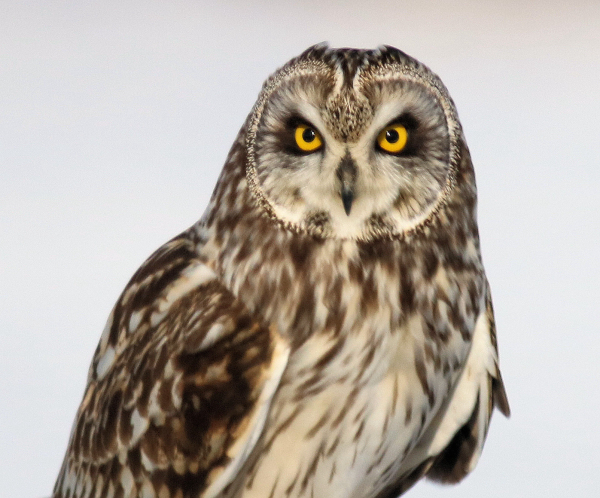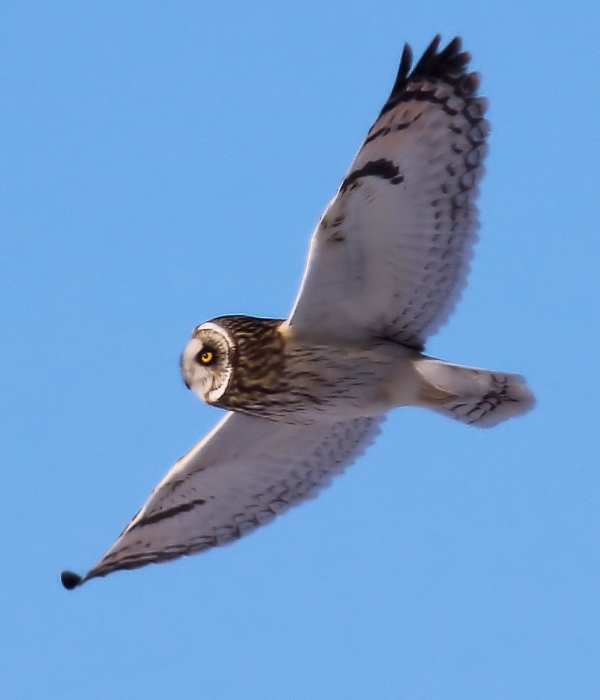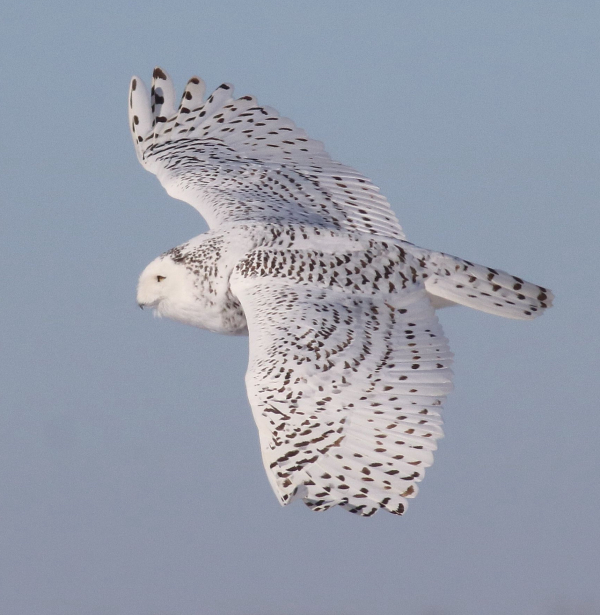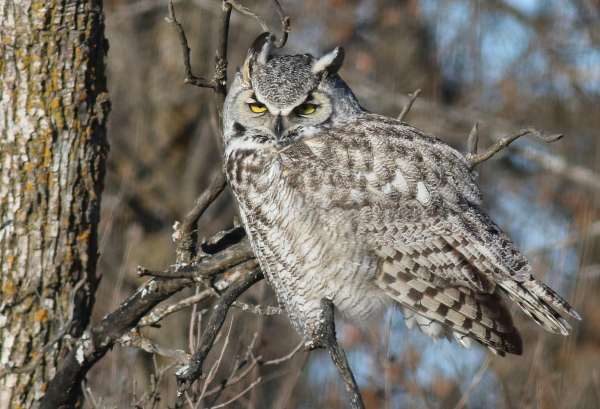
Finding a trifecta of owls was a highlight of a short birding drive last Saturday, including a Short-eared Owl, a Snowy Owl, and a Great Horned Owl.

An opportunity to observe a hunting Short-eared Owl coursing over a large grassland was a winter treat.

Following the flight of a Snowy Owl for about a mile pressed Paul farther afield to try to relocate it. As a result, he found the Short-ear and Great Horned Owls within a couple miles.

A wintering or resident Great Horned Owl? Local Great Horned Owls will begin nesting in about 5 weeks.
|
An overcast, drizzly, almost foggy Saturday afternoon didn’t look very promising, and my drive 7 miles north and back yielded no birds. But south of my office a rooster Ring-necked Pheasant broke the drought, and a flock of 5 Horned Larks added a little juice to my hopes for more birds. Little did I expect 3 owls to add zest to my drive – a Snowy Owl, a Short-eared Owl, and a Great Horned Owl, in that order. The Snowy was a mere blip on the outline of the top of a prairie hill; I could only see the possible outline of its head from a quarter-mile distance.
Before I could double-check the possibility of the Snowy, it took flight in my direction, flying south then southwest as I followed its path until I lost sight of it after a mile. Not one to give up so easily, I decided to extend my drive 2 miles south, 2 miles east, then north to try to re-find the young Snowy Owl. I was proud of my sighting prowess, having spied that owl with the slightest indication of its presence. Through experience and my considerable gift of far-sightedness that often spans to the horizon, I do see my share of hard to find birds. But about the time I was done patting myself on the back, a Short-eared Owl surprised me just a few feet away.
The smaller owl seemed to be as surprised as I was, and I just kept driving down the road with the hope it would remain perched cryptically on the roadside fencepost. How the heck did I miss that bird! I stopped and checked it out with binoculars, only to see it take flight and begin hunting above the adjacent hayfield, making wide circling flights that measured several hundred feet in diameter and covering plenty of ground with intense vision and hearing in the process. The owl dipped low a couple times, and almost hovered a couple more as I watched it in action for a while – this being the first Short-eared Owl I’ve seen in a couple years.
Short-eared Owls tend to be cyclic as winter visitors, but when you see one you usually have a good chance of seeing more. The best winter congregation I’ve appreciated numbered up to a dozen that hunted a grassland for voles and mice over a couple months – but that was almost 20 years ago. I continued up the road a couple more miles, stopping twice to scan the landscape with my binoculars for the original owl – the Snowy – but I didn’t see another bird and headed for home. On my way though, I found a Great Horned Owl perched on the edge of a tree grove – owl number 3, a surprise trifecta!
Sunday revealed new flocks of Lapland Longspurs north and south of my office, with 2 Snow Buntings in a flock of about 40 longspurs. A few Horned Larks were still present, and I sighted a flock of 6 Sharp-tailed Grouse, apparently flying to a feeding site in a harvested ag field. A highlight was seeing a Northern Shrike perched about 7 miles south. I hoped to re-connect with a Snowy or Short-eared Owl – or find new ones – but my search turned up 2 other significant owls, 2 Great Horned Owls; one perched in a tree about 10 miles to the south, and another apparently hunting on the ground and from a rock pile just a mile south of the office.
Second Merlin Sighting
After observing a Merlin just a half mile west of home last Monday, as I was driving to Fargo on Friday afternoon, I was excited to see my second Merlin of the week. A couple miles west of Valley City, this big female Merlin was standing on the ground, feeding on a large bird near the highway. I stopped and took a couple documentary photos in the near-foggy weather. As I was about to leave, the Merlin took a short flight to a nearby cottonwood tree, showing a bulging crop of food. That’s when the biologist in me took over; I was interested in what large bird the Merlin was feeding on, which is pretty uncharacteristic of this small bird specialist.
Hoping I wouldn’t bother the Merlin too much more, I walked out to the kill site and saw the mostly consumed carcass of a Rock Pigeon. I hustled back to my vehicle and on down the road hoping the Merlin would return to its nearly finished feast. But I was surprised and questioned whether the Merlin had caught the pigeon itself, whether it took over an abandoned Peregrine or Cooper’s Hawk kill, or if it was scavenging a roadkill.
Using it as a learning experience, I referred to the Birds of the World website, but there was no mention of Merlins taking such large prey as a pigeon. That’s when I contacted my friend Bill Clark, one of the world authorities on birds of prey, who related “A hungry female Merlin will take a pigeon,” also citing that he has caught Merlins for banding by using a protected pigeon as a lure.
I also asked my primary university professor who is also a renowned raptor biologist, Jim Grier, if he knew of any examples of Merlins taking pigeons. He dug a little deeper, into published scientific publications, and found that a study of Merlins nesting in the city of Saskatoon, Saskatchewan, found 4 Rock Pigeons among the 1,332 prey items identified at Merlin nest sites. So Merlins do prey on birds as large as Rock Pigeons, but only very rarely. Nonetheless, I only observed the big Merlin feeding on the Rock Pigeon, so that’s where I must leave my report to you.
Closer to Home
I appreciated a couple visits to my feeding station by a male Downy Woodpecker one day – another apparent one-day wonder – along with the female that preceded it by a couple days. The Hairy Woodpeckers haven’t been very regular either, but I appreciated a couple visits from the seed-eating female last week. Both species of nuthatches are regular, along with House Finches, but I think the poor feeder action lately is due to the lack of snow cover and very unseasonal temperatures in the 30s and 20s that keeps birds from relying on my attractive handouts.
While I appreciate our northern reprise from the horrors of January weather, I expect winter will take over soon. Actually, there’s a bit of a blizzard forecast for Friday in these parts, which will probably bring more birds to my feeders. I’ll keep ya posted. In the meantime, I hope you are enjoying a fine start to the year. Birding is a great way to break up any day, to add a level of excitement to our planning and during our field trips, and to keep us alert for new birds at our feeders and backyard habitats. Stay safe, healthy, and enjoy all your birding endeavors as best you can during the “vaccination season.”
Article and photos by Paul Konrad
Share your bird sightings and photos at editorstbw2@gmail.com